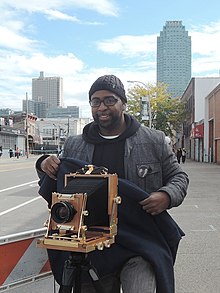This article includes a list of general references, but it lacks sufficient corresponding inline citations. (November 2009) |

Analog photography, also known as film photography, is a term usually applied to photography that uses chemical processes to capture an image, typically on paper, film or a hard plate. These processes were the only methods available to photographers for more than a century prior to the invention of digital photography, which uses electronic sensors to record images to digital media. Analog electronic photography was sometimes used in the late 20th century but soon died out.
Photographic films utilize silver halide crystals suspended in emulsion, which when exposed to light record a latent image, which is then processed making it visible and insensitive to light.
Despite a steep decline in popularity since the advent of digital photography, film photography has seen a limited resurgence due to social media and the ubiquity of digital cameras.[1] With the renewed interest in traditional photography, new organizations (Film Is Not Dead, Lomography) were established and new lines of products helped to perpetuate analog photography. In 2017 B&H Photo & Video stated that film sales were increasing by 5% each year in the recent past.[2]
- ^ "The photographers who refuse to abandon traditional film cameras". BBC News. 2015-04-18. Retrieved 2020-10-05.
- ^ "The Great Film Renaissance Of 2017". B&H Explora. Retrieved 2020-10-05.